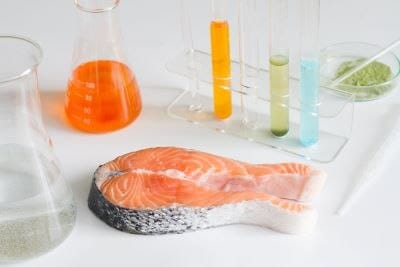Water for Kjeldahl Analysis

Kjeldahl method: Analyzing nitrogen content in diverse samples
The Kjeldahl method is an analytical method for the quantitative determination of nitrogen in chemical substances. It was originally developed by Johan Kjeldahl in 1883 to measure the amount of protein in the grain used to produce beer. It is a standard method for estimating the protein content in foods, animal feed and beverages, where protein content often determines the value of a product.
One drawback of the Kjeldahl method is that it does not give a measure of true protein content, as it measures non-protein nitrogen in addition to the nitrogen in proteins. Despite its limitations, the Kjeldahl nitrogen method remains relevant today and is widely used due to its reliability, accuracy and versatility in analyzing nitrogen-containing compounds across various industries and scientific disciplines.1
The Kjeldahl method is also used to measure nitrogen in organic and inorganic samples in the chemical industry, the pharmaceutical industry, and in environmental samples. Total Kjeldahl nitrogen (TKN) is the sum of nitrogen bound in organic substances, nitrogen in ammonia (NH3-N), and nitrogen in ammonium (NH4+-N). TKN is a required parameter for regulatory reporting at many water treatment plants, and as a means of monitoring plant operations.
Three key steps of the Kjeldahl method
The traditional Kjeldahl method comprises three main steps:
- Digestion: The sample is heated with concentrated sulfuric acid, which decomposes the organic substances by oxidation to liberate the reduced nitrogen as ammonium sulfate. Potassium sulfate is then added to increase the boiling point of the medium.
- Distillation: The solution is then distilled with sodium hydroxide, which converts the ammonium salt to ammonia.
- Titration: The amount of ammonia present (hence the amount of nitrogen present in the sample) is usually determined by titration. A known amount of acid solution is added to the receiving flask. The excess acid is back titrated using a base. Methyl orange is used as a pH indicator. Boric acid may be used for the titration.
Other methods routinely used in the food industry include the Dumas method and methods using UV-spectroscopy and refractive index measurement.2 Novel hybrid techniques are emerging that combine Kjeldahl digestion and other techniques like ion chromatography to eliminate the distillation and titration steps of the method, thereby reducing analysis time while improving precision and accuracy. Since the hybrid test requires much less starting material, it is particularly useful for biological samples that are limited.3
The impact of water quality on Kjeldahl total protein analysis
Water is used in many steps of the Kjeldahl analysis. It is used in the preparation and dilution of the reagents, standards and samples, and for rinsing the glassware and the apparatus. Water may also be used after the digestion step, and to generate steam for the distillation step of the analysis. It may also be used for cooling (in condensers, etc.).
The following water contaminants may interfere with the Kjeldahl analysis and should be avoided:
Ammonia and nitrogen-containing molecules
All nitrogen-containing compounds should be kept to a minimum as these molecules (organic or inorganic) may interfere with the analysis, and lead to erroneously high results. For instance, nitrates can disturb the nitrogen mass balance.
Ions and metals
Calcium and magnesium salts, as well as metals (iron, copper and manganese) may generate deposits when the water is heated to produce steam. These deposits may restrict water flow and reduce the heat exchange efficacy of the steam generator. More frequent maintenance will also be needed.
Particles
Particles may form deposits in the vessels or when steam is generated. Removing these deposits may be cumbersome.
Bacteria
Bacteria levels should be kept to a minimum as they may form biofilms in the steam generator and lead to additional need for maintenance. Bacteria also release by-products, including nitrates, nitrites and other nitrogen-containing compounds, that may interfere with the analysis.
Water quality considerations for the Kjeldahl analysis and related methods
Pure water, ASTM® D1193 type II or equivalent, free of ammonia and nitrogen-containing compounds, and low in ions, metals, particles and bacteria is recommended for Kjeldahl analysis.
Some instruments, originally designed to perform Kjeldahl analysis, offer the option to perform related analyses, such as Total Kjeldahl Nitrogen (TKN) or Devarda analysis, or to analyze volatile components, such as Total Volatile Basic Nitrogen (TVB-N). It is important to follow manufacturer’s guidelines regarding the water quality to use with these instruments.
A range of water purification solutions adapted to the needs of scientists performing nitrogen analyses is available.
Related Products
Kjeldahl Supplies
References
Pour continuer à lire, veuillez vous connecter à votre compte ou en créer un.
Vous n'avez pas de compte ?